There’s some snobby old blighters out there. All the collectors are going for B. James and Hardys stuff. You see the adverts in the angling press every week – WANTED Rods by B. James and Hardys. Most worryingly to me, folks who are so taken by supposedly grand names are unlikely to be genuine users. I’ve a sneaking suspicion that these rods end up in what are euphemistically called ‘collections’. Oh dear: more heartless pins through lovely butterflies. How shallow, and how boring, these pin-stickers.
I’ve heard them talking. ‘Has it got it’s full label: is the varnish all original: is the rod-bag as new: that doesn’t look like the original rod-stopper’. Rods made to be used, are instead leaned into mahogany showcases, and spotlights trained to show off their regimented order to best advantage: to whom, I wonder? The source of this posturing may be sexual. Peacocks do the same sort of thing with their tail feathers. At present, it’s the James and Hardys names they want, and you’d think no other manufacturers of split cane rods had ever existed. Well I suppose I should be grateful that they’re so short-sighted, but that’s far from the truth. Because between them those two manufacturers can’t have accounted for more than 5% of all the split cane rods made in the last 100 years. Indeed, B. James were very much a Johnny-come-lately in the rod world, and they made or assembled rods for only about 20 years.
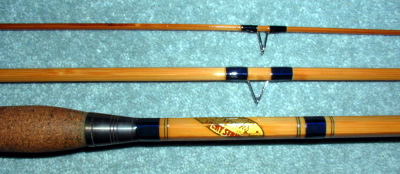
| Restored early Lucky Strike |
No, given the opportunity to choose only one maker of split cane rods, I’d unhesitatingly go for the far less prestigious firm of Allcocks. With a history dating from the last quarter of the 19th century to the late 1960’s, they produced enough good rod designs to keep any traditionalist angler happy for several lifetimes. My enthusiasm for the blissfully wonderful Allcocks Wizard is well known, but Allcocks also produced lots of other marvellous tapers over the years. I recently added another of them to my pile of proper user rods – a Lucky Strike.
The Lucky Strike has been around since the late 1930’s. It’s not what you’d call a SERIOUS rod; not one angling gurus and specialists would describe as a top drawer essential. Pin-sticker collectors wouldn’t give it a second glance. It’s really not much more than a boy’s rod. But Allcocks did something special with this one – they got the tapers right. Have you ever heard that old angling description of a nice rod – it springs to hand. Well that’s the feeling you get with the Lucky Strike. It’s 10’6″ of finely-tempered split cane. A delicious little float rod with character, and ability.
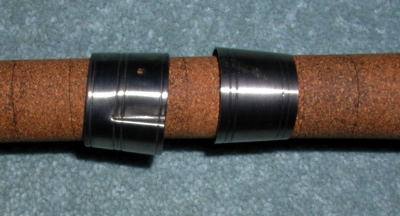 |
|
Early Reel Bands |
Allcocks being Allcocks – that is, a pragmatic, and dare one say, a rather lackaday bunch – Lucky Strikes vary more than a bit from year to year of their manufacture. There’s no doubt, the early ones are best. They’re finer in the tip, and more ruthlessly heat treated to give them a really tight steely feel. The later rods – those with the black and green rectangular label, are meatier in the tip, so they feel rather more limber in action. The late rods sometimes have very short handles, and simple tube ferrules too, rather than the proper serrated jobs found on the early rods. You get the impression that Allcocks purposely down-rated the rod in its late incarnations; perhaps in order to retain its appeal to impoverished youthful anglers of the time. All the same, the cane is still good quality stuff, so for anyone who has the time and the ability to bring the rod up to a better specification, it’s a darn good project rod. So, anyway, this old Lucky Strike came my way. A lovely little thing with its early gold oval label. Allcocks aficionados know very well that the gold oval harks back to the glory days of Allcocks. It’s a badge of quality. The rod was restored to what passes for perfection in my rude workshop, and duly christened by a lusty little chub from a river Test backwater. The Lucky Strike is just the job for bushwacky streams like that.
I showed the rod to some of the boys when next we foregathered. What an acquisitive and sticky-fingered lot they turned out to be. I had to wrestle the rod back. But Stuart Tod had an idea – he thought he might be able to duplicate it. Back in the workshop I used a space-age digital vernier to measure the old Lucky Strike. I have to tell you, when you get down to measuring in thousandths of an inch, (and sod Europeanised millimetres, I say) you find that these old rods were remarkably inaccurately made, so I took averages of three measurements across the flats of the cane. Whatever its shortcomings in the accuracy department, the rod still felt marvellous. Stu disappeared off for some weeks with my Imperial measurements.
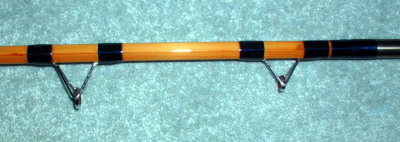
|
Twin lined rings for Sheffield casting |
I quite forgot his promise to make a Lucky Strike until a slim tube arrived in the mail with a short note: ‘I’ve made one for me, and one for you.’ Three dark, flame-tempered rod sections slid into view. Oh! What lovely stuff. The blanks and I fled to the workshop, and a weekend later, impatient to discover its virtues, I was taping on rings in preparation for a few Wallis chucks on the lawn. My little 3″ Aerial balanced it to perfection. As always, Stu’s work was stunning, both aesthetically, and technically. With a quill and a single swanshot, and using Mr. F.W.K Wallis’ beautiful casting regime, it zips out a lovely long line, and surprise surprise, despite the fact that it’s much more accurately made than the original, and much more darkly tempered, it feels just the same as the original Allcocks Lucky Strike. Well of course, it’s all in the taper of the cane. This one’s getting the star treatment. Six coats of varnish on the whippings, a careful sanding, then three coats in the varnish dip tube. It’ll gleam like a lightning bolt when I’ve finished. Just the sort of thing to frighten every fish for miles around. With the season looming, the new rod will soon be paraded for all to see, and maybe to touch – at a price.
In the real world, someone will spirit it off and cover it with mud, but that won’t matter. There’s bound to be an unseemly clamour from the rest of the group who will want Stu to make just one more – just for them, as a special favour. But the poor chap planes up all his bamboo sections by hand, and there are only so many hours in the year. Carbon devotees are swift to declare that cane rods are absolutely unusable because they’re too heavy. It’s an interesting indictment that, and one that sounds as though it’s absolutely and obviously true. But just think about it for a moment. We’re not talking here about 18’ double-built Spey casting salmon fly rods, weighing a pound and a half; but rather, simple float fishing rods between 10’6″ and 12’. I mean, how light do you actually want a rod to be? When is a rod too heavy, and just as importantly, when is it too light?
I unearthed a redundant Shimano Dia-Flash twelve footer from the cupboard the other day, just to remind myself of the joys or otherwise of carbon. Apart from the wholly inappropriate razzamatazzy name, the first thing I noticed was that it was just too light, and insubstantial. I felt as though I was waving a puff of air around: a most unsatisfying sort of feeling. That rod weighed less than five ounces. Then I weighed the Lucky Strike, which turned the scales at 8 ozs. Strangely, it too felt remarkably light. Just out of interest I then weighed my Avocet Barbel rod (12 ozs.) a Hardy Perfection Roach (7 ozs.) a 7’6″ Driggs flyrod (3_ ozs.) and a 12’ Milwards Swimaster (10 ozs.). In other words, leaving aside the sort of thunder sticks you wouldn’t really have a use for these days, cane rods don’t actually weigh very much.
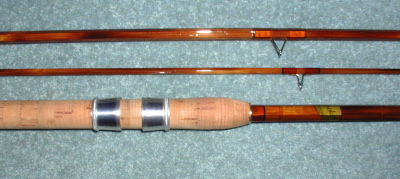 |
|
The Lucky Strike Reproduction |
British anglers can’t all have become emaciated tidily-wink players. Your average non-woosy man who can successfully slice the top off his boiled egg in the morning really shouldn’t have too much trouble with rods like that. The thing is, light enough is probably just and exactly that. Any further reduction in weight is unnecessary, and possibly less satisfactory. Would that Shimano Dia-Flash be a nicer rod if it weighed 2 ozs., or 1 oz., or .5oz.? I fish cane rods up to 12’ all day without ever thinking for a moment about their weight. Clearly, they’re not as light as they could be, but they’re light enough, and they feel right.
Let me tell you something else: cane rods seem to bounce far fewer fish than do carbon. Of course, it may be that there are attendant disadvantages, like the possibility of ultra-light hook-lengths breaking with the extra ‘clonk’ from the tip; but in my experience the greater weight of the cane tip seems to tap-in the hook just nicely. I know that technically (that is, measured on a computer, or on graph paper, where cold-hearted figures can be made to sell any idea in the world) they can’t hold a candle to the latest carbon designs, but for some reason best known to the river gods, they don’t arf catch a lot of fish. It could be that those river gods feel slightly more in tune with wood than with something that starts its life as a stress curve generated by Microsoft Excel, with the aid of a Pentium 3 microchip.
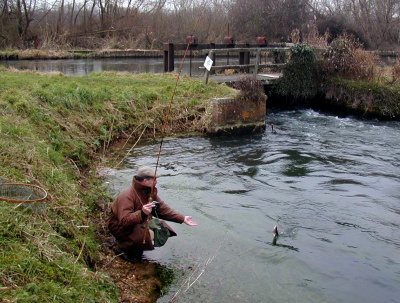
| A grayling falls to the Lucky Strike |
So, to finish off the Lucky Strike story: provided you’re not expecting to haul ruddy great chub back through waving weed-beds, (which in any case is more a matter of pull Johnny pull, and line strength, rather than rod strength) I reckon there’s not much you couldn’t do with this lovely little rod. I’ll happily team it up with 2 – 4 lb. line, and I’ll use it whenever the magic Wizard is just a bit too butch. The dace will queue up to be caught on such a perfect wand, and it’ll suit the roach and grayling just fine too. The back-streams and carriers await its presence, and if I finally catch that first, long-sought-after, pounder dace on my new Lucky Strike, you’ll be the first to hear about it.
John Olliff-Cooper










